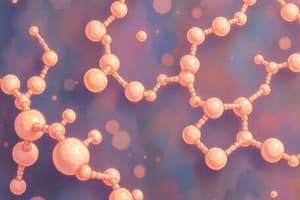Podcast
Questions and Answers
What is the role of the R group in an amino acid?
What is the role of the R group in an amino acid?
- Determines the sequence of the amino acid chain
- Causes the polypeptide to fold into a biologically active shape
- Gives each amino acid its identity (correct)
- Forms the amide bond
How many amino acids are needed to form a dipeptide?
How many amino acids are needed to form a dipeptide?
- 2 (correct)
- 5
- 10
- 3
Which type of bond joins amino acids together to form peptides and proteins?
Which type of bond joins amino acids together to form peptides and proteins?
- Peptide bond (correct)
- Ionic bond
- Covalent bond
- Hydrogen bond
What happens when the number of amino acids in a polypeptide chain exceeds 40?
What happens when the number of amino acids in a polypeptide chain exceeds 40?
Which type of amino acids are the building blocks of proteins in the body?
Which type of amino acids are the building blocks of proteins in the body?
What are proteins made up of?
What are proteins made up of?
What is the main purpose of the Biuret test?
What is the main purpose of the Biuret test?
What is the minimum number of peptide bonds required for a positive Biuret test?
What is the minimum number of peptide bonds required for a positive Biuret test?
What is the reverse process of hydrolysis?
What is the reverse process of hydrolysis?
What is the purpose of the Ninhydrin test?
What is the purpose of the Ninhydrin test?
What is the general test for carbohydrates?
What is the general test for carbohydrates?
Why do antibiotics not always produce a predictable result in the Biuret test?
Why do antibiotics not always produce a predictable result in the Biuret test?
Which test is used to detect the presence of aromatic amino acids?
Which test is used to detect the presence of aromatic amino acids?
Which amino acid is egg albumin lacking?
Which amino acid is egg albumin lacking?
What is the purpose of the Millon's Test?
What is the purpose of the Millon's Test?
Which test result indicates the presence of tryptophan?
Which test result indicates the presence of tryptophan?
Which amino acid is considered stable in phenylalanine and does not react with the reagent in the Xanthoproteic Test?
Which amino acid is considered stable in phenylalanine and does not react with the reagent in the Xanthoproteic Test?
Which test is used to detect the presence of sulfhydryl-containing amino acids?
Which test is used to detect the presence of sulfhydryl-containing amino acids?
Flashcards are hidden until you start studying
Study Notes
Peptide Bonds and Amino Acids
- Peptide bonds are formed through a condensation reaction, combining simple compounds to create a complex compound and releasing water.
- Amino acids are joined together, releasing water, to form polypeptides.
- Formation of polypeptides involves removing oxygen from the precedent amino acid and two hydrogens from the subsequent amino acid, then placing the groups next to each other.
Protein Tests
- Biuret Test: general test for proteins, indicating the presence of amide/peptide bonds, resulting in a purple/violet solution.
- Dipeptide and amino acid will have a negative test, while tripeptide, tetrapeptide, and pentapeptide will have a positive test.
- 40 amino acids or more are considered a protein.
Amino Acid Tests
- Ninhydrin Test: tests for the presence of α-amino acid in proteins, resulting in a blue-violet/purple-blue solution.
- Alanine is an amino acid and will have a positive test.
- Egg albumin contains 18 amino acids, except glutamine and asparagine.
Aromatic Amino Acids
- Xanthoproteic Test: tests for the presence of aromatic amino acids, resulting in a yellow/orange-yellow solution.
- Egg albumin contains all aromatic amino acids, including tyrosine and tryptophan.
- Phenylalanine is an aromatic amino acid but does not react with the reagent, resulting in a negative test.
Phenol and Tyrosine
- Millon’s Test: tests for phenolic compounds and detects the presence of tyrosine, the only amino acid containing a phenol group, resulting in a pink/red/brick-red precipitate.
Tryptophan
- Hopkins-Cole Test: tests for the presence of tryptophan, the only amino acid containing an indole group, resulting in a violet-ring at the junction.
Sulfhydryl-Containing Amino Acids
- Lead Sulfide Test: tests for the presence of sulfhydryl-containing amino acids.
Amino Acid Structure
- Amino acids are organic compounds containing an amino group and a carboxyl group.
- The 20 common amino acids used to build proteins are mostly α-amino acids.
- The sequence of the amino acid chain causes the polypeptide to fold into a shape that is biologically active.
- The amino acid sequences of proteins are encoded in the genes.
Protein Classification
- 2-39 amino acids are considered polypeptides.
- Exceeding 40 amino acids, it will be called a protein.
- Alpha amino acid: 19 out of 20 amino acids are alpha amino acids.
- Not an alpha amino acid is an Imino acid; proline.
Studying That Suits You
Use AI to generate personalized quizzes and flashcards to suit your learning preferences.




